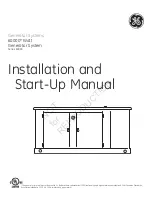
29
5.8.2
Procedure
Warning
Only
use
nitrogen
for
flushing.
Using
carbon
dioxide
risks
leaving
condensation
in
the
piping.
Oxygen,
air,
refrigerant,
flammable
gases
and
toxic
gases
must
not
be
used
for
flushing.
Use
of
such
gases
may
result
in
fire
or
explosion.
Procedure
The
liquid
and
gas
sides
can
be
flushed
simultaneously;
alternatively,
one
side
can
be
flushed
first
and
then
Steps
1
to
8
repeated,
for
the
other
side.
The
flushing
procedure
is
as
follows:
1. Cover
the
inlets
and
outlets
of
the
indoor
units
to
prevent
dirt
getting
blown
in
during
pipe
flushing.
(Pipe
flushing
should
be
carried
out
before
connecting
the
indoor
units
to
the
piping
system.)
2. Attach
a
pressure
reducing
valve
to
a
nitrogen
cylinder.
3. Connect
the
pressure
reducing
valve
outlet
to
the
inlet
on
the
liquid
(or
gas)
side
of
the
outdoor
unit.
4. Use
blind
plugs
to
block
all
liquid
(gas)
side
openings,
except
for
the
opening
at
the
indoor
unit
which
is
furthest
from
the
outdoor
units
(“Indoor
unit
A”
in
Figure
3
‐
5.11).
5. Start
to
open
the
nitrogen
cylinder
valve
and
gradually
increase
the
pressure
to
0.5MPa.
6. Allow
time
for
nitrogen
to
flow
as
far
as
the
opening
at
indoor
unit
A.
7. Flush
the
first
opening:
a) Using
suitable
material,
such
as
a
bag
or
cloth,
press
firmly
against
the
opening
at
indoor
unit
A.
b) When
the
pressure
becomes
too
high
to
block
with
your
hand,
suddenly
remove
your
hand
allowing
gas
to
rush
out.
c)
Repeatedly
flush
in
this
manner
until
no
further
dirt
or
moisture
is
emitted
from
the
piping.
Use
a
clean
cloth
to
check
for
dirt
or
moisture
being
emitted.
Seal
the
opening
once
it
has
been
flushed.
8. Flush
the
other
openings
in
the
same
manner,
working
in
sequence
from
indoor
unit
A
towards
the
outdoor
units.
Refer
to
Figure
3
‐
5.12.
9. Once
flushing
is
complete,
seal
all
openings
to
prevent
dust
and
moisture
from
entering.
Figure
3
‐
5.12:
Pipe
flushing
sequence
1
Notes:
1. 1
‐
2
‐
3
‐
4
‐
5
‐
6
working
towards
the
outdoor
units.
Notes
for
installers
Figure
3
‐
5.11:
Pipe
flushing
using
nitrogen
ni
tr
og
en
ga
s
cylind
er
Outdoor
unit
Indoor
unit
A
liquid
pipe
gas
pipe
Indoor
unit
B
②
⑥
⑤
④
③
①
















































